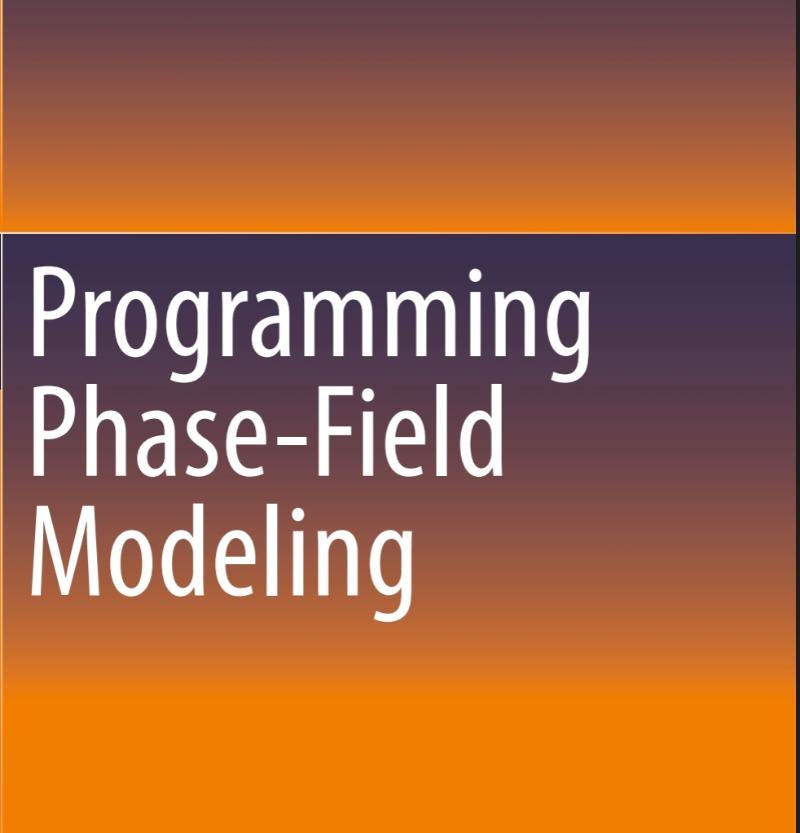
莫负金穗浪·轻步落枫风
-

-

III
-

Programming Phase-Field Modeling - Chapter 4
Finite difference algorithms offer a more direct approach to the numerical solution of partial differential equations than any other method. Finite difference algorithms are based on the replacement of each derivative by a difference quotient. Finite difference algorithms are simple to code, economic to compute, and easy to parallelize for the distributed computing environments. However, they also have disadvantages in terms of accuracy and imposing complex boundary conditions. For better understanding of the method, the solution of one-dimensional transient heat conduction is given as an example together with the source code in this section.
-

Programming Phase-Field Modeling - Chapter 2
Many of the fundamental theories of physics and engineering, including the phase-field models, are expressed by means of systems of partial differential equations, PDEs. A PDE is an equation which contains partial derivatives, such as in which u is regarded as function of length x and time t. There is no real unified theory for PDEs. They exhibit their own characteristics to express the underlying physical phenomena as accurately as possible. Since PDEs can be hardly solved analytically, their solutions relay on the numerical approaches. A brief of summary of the numerical techniques involving their spatial and temporal discretization is given below. These techniques will be applied to solving the equations of the various phase-field models throughout the book and their detailed descriptions and implementations are given in relevant chapters. There are numerous textbooks also available on the subjects, of which some of them are listed in the references.
-

Programming Phase-Field Modeling - Chapter 1
A microstructure can be described as the spatial arrangement of the phases and possible defects that have different compositional and/or structural character (for example, the regions composed of different crystal structures and having different chemical compositions, grains of different orientations, domains of different structural variants, and domains of different electric or magnetic polarizations). The size, shape, volume fraction, and spatial arrangement of these microstructural features determine the overall properties of any type of multiphase and/or multicomponent materials.
-

多幸运
材料成型金属学补充-6
Even under the most ideal crystal growth conditions, metals are not crystallographically perfect. Instead, the lattice may contain many imperfections.

精选分类
-
programming-phase-field-modeling
Programming Phase-Field Modeling
进入分类-

Programming Phase-Field Modeling - Chapter 4
Finite difference algorithms offer a more direct approach to the numerical solution of partial differential equations than any other method. Finite difference algorithms are based on the replacement of each derivative by a difference quotient. Finite difference algorithms are simple to code, economic to compute, and easy to parallelize for the distributed computing environments. However, they also have disadvantages in terms of accuracy and imposing complex boundary conditions. For better understanding of the method, the solution of one-dimensional transient heat conduction is given as an example together with the source code in this section.
60° 来说一句 -

Programming Phase-Field Modeling - Chapter 2
Many of the fundamental theories of physics and engineering, including the phase-field models, are expressed by means of systems of partial differential equations, PDEs. A PDE is an equation which contains partial derivatives, such as in which u is regarded as function of length x and time t. There is no real unified theory for PDEs. They exhibit their own characteristics to express the underlying physical phenomena as accurately as possible. Since PDEs can be hardly solved analytically, their solutions relay on the numerical approaches. A brief of summary of the numerical techniques involving their spatial and temporal discretization is given below. These techniques will be applied to solving the equations of the various phase-field models throughout the book and their detailed descriptions and implementations are given in relevant chapters. There are numerous textbooks also available on the subjects, of which some of them are listed in the references.
24° 来说一句 -

Programming Phase-Field Modeling - Chapter 1
A microstructure can be described as the spatial arrangement of the phases and possible defects that have different compositional and/or structural character (for example, the regions composed of different crystal structures and having different chemical compositions, grains of different orientations, domains of different structural variants, and domains of different electric or magnetic polarizations). The size, shape, volume fraction, and spatial arrangement of these microstructural features determine the overall properties of any type of multiphase and/or multicomponent materials.
62° 来说一句
-
-
music_share
每日一曲
进入分类-

Sacred Play Secret Place
22° 来说一句 -

III
15° 来说一句 -

多幸运
15° 来说一句 -

Poker Face
13° 来说一句
-
最新图文动态
-

材料成型机械设备-第一章复习题
15° 来说一句
最新视频动态
走心评论
草木风
发表在「考研英语每日一词【2024年8月8日】」
虽然只能看到一半的单词,但是好开心😊谢谢你!
草木风
发表在「Letter」
Your friendship means so much to me
Mu Yuan
发表在「空叹兮」
桃之夭夭,灼灼其华。
zyl
发表在「勿念他归」
《千本樱》啊

